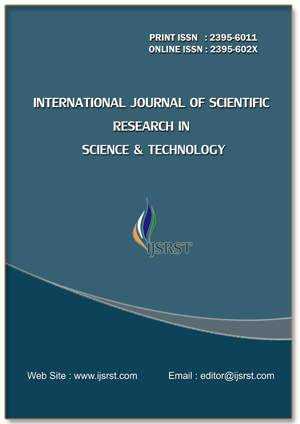Nutritional and Cultural Significance of Traditional Fermented Fish Products in North-East India – A Review
DOI:
https://doi.org/10.32628/IJSRST251222692Keywords:
Fermented Fish, Nutritional Benefits, Cultural Heritage, North-East India, Traditional CuisineAbstract
Currently, this study delves into the nutritional and cultural importance of traditional fermented fish products from North-East India, namely Ngari, Hentak, Tungtap, Shidol, and Ngar-Ping. These indigenous culinary delights are not only integral to the local diet but also embody centuries-old food preservation techniques. Rich in proteins, essential fatty acids, vitamins, and minerals, these products offer significant health benefits, including enhanced gut health due to their probiotic contents. Additionally, the fermentation process enhances the bioavailability of nutrients, making these foods nutritionally superior. Their unique flavours contribute to the culinary diversity of the region, while their cultural significance fosters community identity and continuity of traditional practices. This exploration underscores the vital role of fermented fish products in supporting both the nutritional needs and cultural heritage of North-East Indian communities.
📊 Article Downloads
References
Chakraborty, R., & Bhattacharya, P. (2020). Traditional fermented fish products of North-East India: A review. Journal of Ethnic Foods, 7(1), 1-8.
Das, A. J., & Deka, S. C. (2012). Fermented foods and beverages of the North-East India. International Food Research Journal, 19(2), 377-392.
Deori, C., Begum, S. S., & Deka, S. C. (2017). A review on traditional fermented foods and beverages of Assam, North-East India. International Journal of Food Fermentation Technology, 7(2), 207-220.
Ghosh, K., Ray, R. C., & Adak, S. (2020). Fermented fish products: Biochemistry, microbiology, and health benefits. In R. C. Ray & S. Adak (Eds.), Fermented Foods: Biochemistry and Biotechnology (pp. 225-246). CRC Press.
Kakati, B. K., Gogoi, B., & Tamuli, K. J. (2016). Microbiological and biochemical aspects of fermented fish products of North-East India. Journal of Food Science and Technology, 53(1), 1-12.
Majumdar, R. K., & Basu, S. (2017). Characterization of traditional fermented fish products of Northeast India. Journal of Food Processing and Preservation, 41(6), e13280.
Patra, J. K., Das, G., Paramithiotis, S., & Shin, H. S. (2016). Kimchi and other widely consumed traditional fermented foods of Korea: A review. Frontiers in Microbiology, 7, 1493.
Roy, P. K., Baruah, A., & Dutta, A. (2014). Traditional fermented foods and beverages of Assam. Journal of Ethnic Foods, 1(2), 69-75.
Saikia, S., Deka, S. C., & Deka, K. (2018). Probiotic potential of traditionally fermented fish products of North-East India. Journal of Applied Microbiology, 125(2), 456-467.
Saha, P., & Ray, R. (2019). Fermented fish products of India. In A. Sarkar (Ed.), Fermented Foods: Part II (pp. 173-187). Springer.
Das, A. J., & Deka, S. C. (2012). Fermented foods and beverages of the North-East India. International Food Research Journal, 19(2), 377-392.
Devi, S. S., & Kumar, P. S. (2018). Nutritional and microbial profile of Ngari: A traditional fermented fish product of Manipur. Journal of Food Science and Technology, 55(3), 967-977. https://doi.org/10.1007/s13197-017-2997-6
Devi, S. S., Suresh, A., & Halami, P. M. (2020). Traditional fermented fish products of Northeast India: A review on its production, nutritional composition, and microbiological quality. Food Bioscience, 36, 100622. https://doi.org/10.1016/j.fbio.2020.100622
Jeyaram, K., Singh, T. A., Romi, W., Devi, A. R., Singh, W. M., Dayanidhi, H., ... & Tamang, J. P. (2009). Traditional fermented foods of Manipur. Indian Journal of Traditional Knowledge, 8(1), 115-121.
Majumdar, R. K., Roy, D., Bejjanki, S., & Bhaskar, N. (2021). Fermented fish products in South and Southeast Asian cuisine: Microbial and functional aspects. Applied Microbiology and Biotechnology, 105(10), 4013-4027. https://doi.org/10.1007/s00253-021-11337-4
Oki, K., Rai, A. K., Sato, S., Watanabe, K., & Tamang, J. P. (2014). Lactic acid bacteria isolated from ethnic preserved meat products of the Western Himalayas. Food Microbiology, 44, 35-42. https://doi.org/10.1016/j.fm.2014.05.004
Rai, A. K., Tamang, J. P., & Palni, U. (2017). Microbiological studies of ethnic meat products of the Eastern Himalayas. Journal of Ethnic Foods, 4(3), 140-146. https://doi.org/10.1016/j.jef.2017.08.003
Sarkar, P., Nanda, P. K., & Das, S. (2015). Health benefits of fermented fish products. Journal of Nutrition & Food Sciences, 5(5), 1-6. https://doi.org/10.4172/2155-9600.1000423
Sha, S. P., & Kumar, S. (2020). Indigenous fermented fish products of Northeast India: A review on preparation, nutritional composition, and health benefits. Journal of Ethnic Foods, 7(1), 1-12. https://doi.org/10.1186/s42779-020-00056-1
Singh, T. A., Devi, K. R., Ahmed, G., & Jeyaram, K. (2019). Microbial and endogenous origin of fibrinolytic activity in traditional fermented foods of Northeast India. Food Research International, 115, 155-161. https://doi.org/10.1016/j.foodres.2018.08.021
Tamang, J. P. (2015). Naturally fermented ethnic soybean foods of India. Journal of Ethnic Foods, 2(1), 8-17. https://doi.org/10.1016/j.jef.2015.02.003
Tamang, J. P. (2020). Fermented foods and beverages of the world. CRC Press.
Thakur, N., Savitri, & Bhalla, T. C. (2018). Characterization of some traditional fermented foods and beverages of Himachal Pradesh. Indian Journal of Traditional Knowledge, 17(1), 185-193.
Thapa, N. (2016). Ethnic fermented and preserved fish products of India and Nepal. Journal of Ethnic Foods, 3(1), 69-77. https://doi.org/10.1016/j.jef.2016.02.003
Downloads
Published
Issue
Section
License
Copyright (c) 2025 International Journal of Scientific Research in Science and Technology

This work is licensed under a Creative Commons Attribution 4.0 International License.
https://creativecommons.org/licenses/by/4.0




